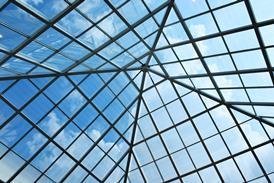There are three ways in which such artists are infiltrating the industry: by contributing to the actual design of buildings at its inception, by joining project teams on building sites to gain inspiration for their own work and finally – and most visibly – by creating monumental commissioned public artworks that require considerable engineering and construction skills, they become part of the whole building process.
"Architects and artists are starting to work together much earlier on," says Amanda Baskner from consultant Art For Offices. "There's an increasing interest in including art as part of the building, not just adding it as an afterthought."
A whole range of artists and craftspeople are now contributing to buildings, including sculptors, jewellers, painters, glasswork experts and lighting artists. Many of the techniques they develop are adopted by architects and become routinely used, according to Danny Lane, a sculptor who creates monumental glassworks. "People are now doing bronze doors and handrails – these started out as innovative art," he says. "An artist has a different relationship to materials than most architecture-related people. We're bringing out the quality of the material in a space."
"Artists have the ability to consider different materials and scale, think laterally and pose questions in the way an architect might not," agrees Vivien Lovell, a former director of the Public Art Commissions Agency. She now runs her own art consultancy, Modus Operandi, which pairs artists with specific construction projects – such as the immense corning design on the front of 111 The Strand in London by Ben Longlands and Nikki Bell (pictured left).
The Royal Society of Arts is keen to encourage such collaborations – so much so that it has created funding body Art for Architecture, which pays the fees for artists to work on site. AfA director Jes Fernie says it's not just beneficial for occupants of the finished building – artists also profit. "They get to work in a completely different context, on a completely different scale and it's liberating," she says. "They're intrigued by the architects and how they work. And architects know artists have a dimension that nobody else on the design team can offer. They ask questions that other people don't ask, about the nature of the project, the scale, the way people use the space. It's about total collaboration."
Such collaboration is not just about contributing to the architecture. Artists are also becoming part of the project team in their traditional role – creating sculptures and installations to adorn the ennui of the corporate lobby. Canary Wharf Group's public art consultant Theresa Bergue says the traditional approach of spotting an empty space in a completed building and searching for an artist to fill it is old-hat and unsatisfactory: "There have been so many cases where art is an add-on at the last minute, and that doesn't work very well. It's not fair on the artists, it's not fair on the space and it often doesn't feel right – it feels a bit odd and uncomfortable. It's really important that the art is considered right from the start."
Canary Wharf is one of the most forward-thinking companies when it comes to the inclusion of art. It now has more than 40 artworks in and around its buildings in London Docklands and has been incorporating art into developments for more than 10 years. Bergue says more developers are becoming keen to follow their lead: "A lot of developers are beginning to realise the value in investing in public spaces in this way, and there's a lot more pressure put on developers to give that attention to detail."
Large-scale artworks pose new challenges for architects and engineers, says Nicholas Faulk from urban regeneration consultant UrbEd. "It's a growing trend," he says. "It's now natural to think of there being a role for artists." One example is the Laban Centre in Deptford, south-east London, a dance school whose multicoloured facade was conceived by artist Michael Craig-Martin in collaboration with architect Herzog & de Meuron.
But innovative creations can cause engineering problems, as William Jeffries, director at architect Squire and Partners explains. "When you start integrating art into a building, it becomes huge in scale. We sometimes fail to appreciate the subtlety and minutiae of what the artist is trying to achieve. And how to get ideas to work technically can be incredibly difficult."
Making the artist understand the technical issues their creations pose can be the most toughest of all the challenges. "The artist doesn't understand how technically hard it is to make what they want, especially when it has to fit all the æ´∂´”∞ ” Regulations and criteria ‚Äì which art in a gallery doesn't. It's hard to explain the practical problems, such as maintenance access." Flexibility and communication are essential. "It's a dialogue. Sometimes the artist goes back and redesigns once they understand the problem."
Still, Michael Coombes, director of consulting engineer Alan Baxter & Associates, is optimistic about solving the problems an on-site artist poses: "Almost inevitably you can find an engineering solution to what the artist is looking for that doesn't compromise the intentions of the artist. It takes time, and the most important thing is to really understand what the artist's vision is, what they're trying to achieve and the thinking behind it." Background knowledge of art helps, he adds: "You have to learn a little to appreciate what the artist is trying to do. You have to understand the qualities of the material and what the parameters are. I'm not artistic myself, but I've learned to understand art through working with artists. Certain engineers find that easier to do than others."
Jeffries concedes that open-minded engineers can get a lot from the collaboration: "It is beneficial; it gives us a chance to work with designers and think more laterally about how we design buildings."
But there is another aspect to these challenges: the permanence of the finished artwork. Ron Arad – an artist or architect, depending on whose view you subscribe to (see "Destroy all categories", below) – believes developers should be careful what they install. "The biggest problem with public art is that you can't get rid of it," he says. "The world is full of bad art, especially in countries that try to have a progressive attitude. Motorways in France are littered with it and it doesn't do anyone any favours."
Many pieces require local authority planning approval, and Arad is scathing about bureaucrats' tastes. "The last thing the local authority wants is public art, as they have differing ideas of what good art is," he says. Dealing with local bodies can be confusing – some are dubious about developers installing art, and others are keen to request the inclusion of art in as many schemes as possible.
One example of the latter is Westminster council, which believes that "all aspects of the urban environment from street furniture to the overall design of a building, materials used and decorative elements can be enhanced by the integration of art into the development at the design stage", according to a spokesperson. Westminster has a Policy For Public Art, which pushes for artists to work on all major developments. "Art can play a valuable role," the spokesperson added. "It's preferable for a developer or architect to work with artists and craftsmen at the outset, rather than to commission them after construction work is over."
For local authorities without a general public art policy, section 106 planning agreements are a way of negotiating the inclusion of art in a scheme. This is an agreement between the developer and the local planners about what extras the developer will install. Street furniture such as lampposts and litter bins are a common choice, as are surrounding roads and public spaces on particularly big schemes. Now public art is cropping up.
"If an art dimension is critical to the development, as it can be in big developments, then it would be expected to be in the 106 agreement," says David Rose of the Royal Town Planning Institute. "It's voluntary whether a developer signs a 106, but if they don't the local authority can refuse planning permission. Usually, local authorities only put in the agreement what they think a developer would accept."
One reason councils are keen on public art is because it can create character in a newly-built space. "Art makes public spaces spring to life and feel unique, as opposed to just something off the shelf," says UrbEd's Faulk. "Art at its best creates a sense of place. It can enhance quality and distinctiveness – the feeling that you're somewhere rather special."
So what's the future for art on construction projects? Michael Coombes thinks collaboration is the way forward: "In the past it was more passive – the artist came up with an idea and the engineer made it work. These days the engineer and the artist develop the artwork together and things work better than if I just had to respond without contributing."
So is this a whole new synthesis of two completely different disciplines? Maybe it's time hard-hat wearers brushed up on their abstract expressionism.
Destroy all categories: Ron Arad

The sliver surfer: Danny Lane

The muse of mud: Louise Holloway

























No comments yet